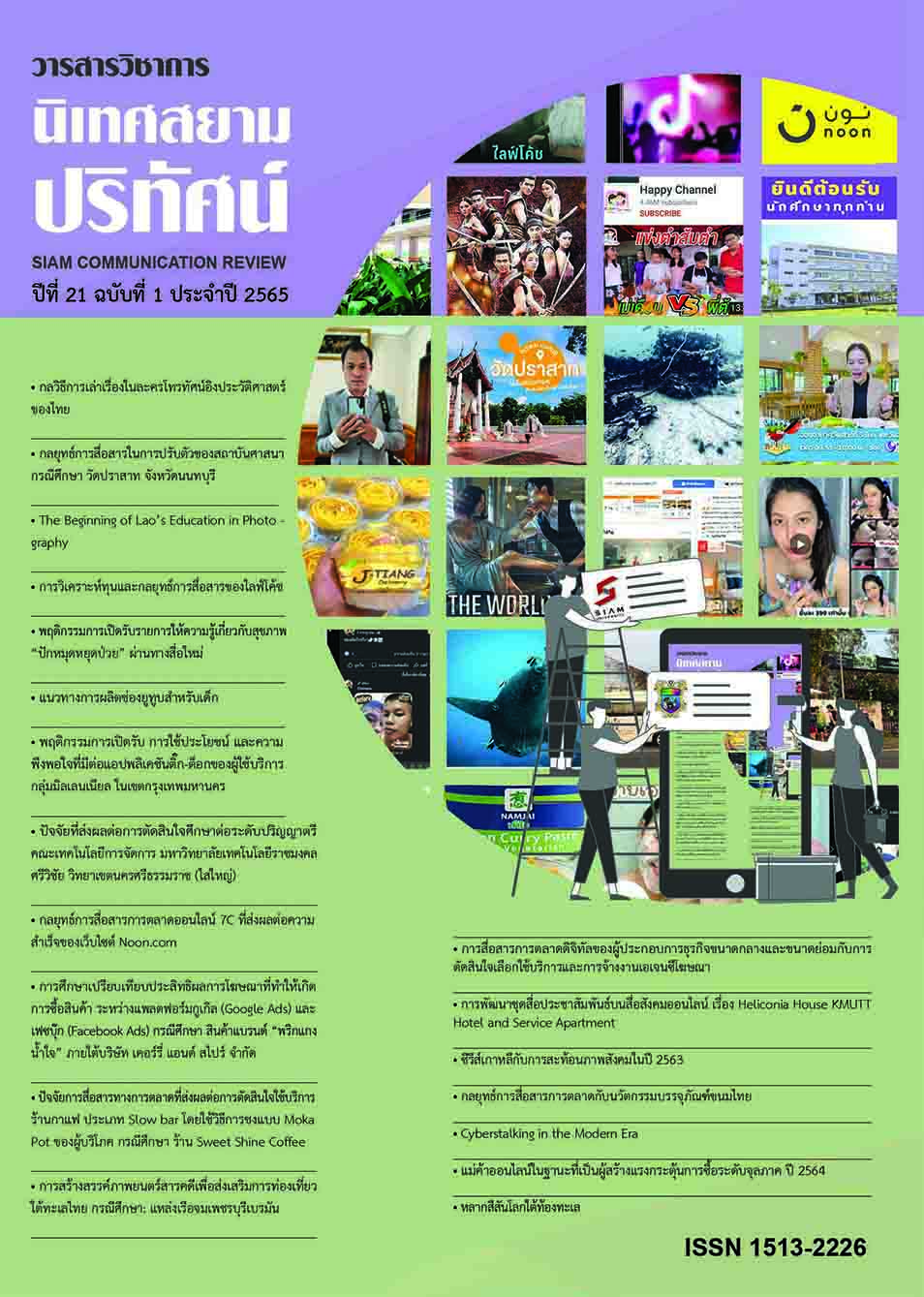Capital Analysis and Communication Strategies of “Life Coach”
Main Article Content
Abstract
The research of capital analysis and communication strategies of “life coach” was qualitative research that aims to study capital accumulation, the extension of capital that lead to be “life coach” and study communication strategies which established themselves as personal media who affect views, beliefs and behavior of individuals. This research has two case studies; Khunkhao Sindhusen Khaejornbut (K.S. Khunkhao) and Pol.Capt. Sethit Amthanom (Capt. Benz). The data was gathered by content analysis from social media of “life coach” and other channels that were written documents and visual documents such as interview videos and online articles. Additionally, in-depth interview from two key informants who are associated with case studies, including friends and colleagues.
The results were found that all case studies have abilities and skills about the capital accumulation, the extension of capital. First, source of the capital accumulation was a primary group that cultivates cultural capital comes to embodied form or “Habitus”, in Bourdieu’s concepts. Habitus was viewed till to behavior as unconscious principle because it was embodied within the body for a long time. However, “life coach” who was case studies accumulated cultural capital from recognized or accredited academic institutions in society and coaching field that was cultural capital in institutionalized form. Both K.S. Khunkhao and Capt. Benz have abilities about the extension of capital and transformation capital to other capital that lead to contribute in their “life coach” role, especially conversion capital to symbolic capital such as popularity and honor which make two case studies so different from other life coaches. Moreover, these findings indicate that two case studies have seven communication strategies: mixed media selection strategies; message selection and modification of substance content; selection of used languages strategies; situational analysis; audience analysis; listening to feedback through social media and product differentiation. These strategies were employed in “life coach” as personal media who have strongly influenced to many aspects of human life, which can include individual views, beliefs and behavior. In addition, communication strategies can make a difference from other life coaches.
Article Details

This work is licensed under a Creative Commons Attribution-NonCommercial-NoDerivatives 4.0 International License.
References
ภาษาไทย
กัญญารินทร์ วัฒนเรืองนันท์. (2558). อิทธิพลของ Beauty Influencers ที่มีต่อพฤติกรรมการซื้อเครื่องสำอางของผู้บริโภคกลุ่มวัยทำงานตอนต้น ในเขตกรุงเทพมหานคร. วิทยานิพนธ์ปริญญามหาบัณฑิต, คณะวารสารศาสตร์และสื่อสารมวลชน สาขาวิชาการจัดการการสื่อสารองค์กร มหาวิทยาลัยธรรมศาสตร์.
กาญจนา แก้วเทพ และสมสุข หินวิมาน. (2551). สายธารแห่งนักคิดทฤษฎีเศรษฐศาสตร์การเมืองกับสื่อสารศึกษา. กรุงเทพฯ: ภาพพิมพ์.
ชนินทร์พร จิราธรวราพัฒน์. (2556). บทบาทรายการวิทยุคลับฟรายเดย์กับการสร้างพื้นที่สาธารณะของผู้ฟัง. วิทยานิพนธ์ปริญญามหาบัณฑิต, คณะวารสารศาสตร์และสื่อสารมวลชน สาขาวิชาสื่อสารมวลชนมหาวิทยาลัยธรรมศาสตร์.
ชาลิดา อรัญทิมา. (2559). ตลกหญิง: การสื่อสารกับการต่อรองพื้นที่ตลกในสื่อโทรทัศน์ไทย. วิทยานิพนธ์ปริญญามหาบัณฑิต, คณะวารสารศาสตร์และสื่อสารมวลชน สาขาวิชาสื่อสารมวลชน มหาวิทยาลัยธรรมศาสตร์.
ดวงพร คงพิกุล. (2555). การผลิตซ้ำทุนทางวัฒนธรรม กรณีศึกษาโรงเรียนพระหฤทัยคอนแวนต์. วิทยานิพนธ์ปริญญามหาบัณฑิต, คณะพัฒนาทรัพยากรมนุษย์ สาขาวิชาเทคโนโลยีการบริหาร มหาวิทยาลัยธรรมศาสตร์.
ต่อสิต กลีบบัว. (2553). การเมืองในการถ่ายภาพท่องเที่ยว การครอบงำและการต่อรองทางวัฒนธรรม. วิทยานิพนธ์ปริญญาดุษฎีบัณฑิต, คณะวารสารศาสตร์และสื่อสารมวลชน สาขาวิชาสื่อสารมวลชน มหาวิทยาลัยธรรมศาสตร์.
นพิชญา จิตร์แจ้ง. (2556). บทบาทของชุมชนคนรักสัตว์ในสังคมออนไลน์. วิทยานิพนธ์ปริญญามหาบัณฑิต, คณะสังคมสงเคราะห์ศาสตร์ สาขาวิชาการพัฒนาชุมชน. มหาวิทยาลัยธรรมศาสตร์.
นรินทร์ชัย พัฒนพงศา. (2542). การสื่อสาร-รณรงค์เชิงยุทธศาสตร์เพื่อเปลี่ยนพฤติกรรมมนุษย์ เน้นการเจาะจงกลุ่มและมีส่วนร่วม. กรุงเทพฯ: รั้วเขียว.
ปรีนาภา ชูรัตน์. (2561). กระบวนการโค้ชเพื่อพัฒนาจิตวิญญาณอาสาสมัครภาคสนามที่ช่วยเหลือผู้ใช้ยาเสพติด การศึกษาผ่านเรื่องเล่า. วิทยานิพนธ์ปริญญาดุษฎีบัณฑิต, บัณฑิตวิทยาลัย สาขาวิชาจิตวิทยาประยุกต์ มหาวิทยาลัยศรีนครินทรวิโรฒ.
พรชัย ตระกูลวรานนท์. (2552). ทุนทางสังคมและประชาสังคม จากทฤษฎีสู่วิธีวิทยา. กรุงเทพฯ: สถาบันสัญญา ธรรมศักดิ์ เพื่อประชาธิปไตย.
พูนศักดิ์ พาทีทิน. (2562). การสื่อสารของผู้นำชุมชนเพื่อการสร้างเสริมสุขภาวะ ด้านการลด ละ เลิก เครื่องดื่มแอลกอฮอล์ : กรณีศึกษา ชุมชนบ้านวัดบางเตย ตำบลบางเตย อำเภอบ้านสร้าง จังหวัดปราจีนบุรี. วิทยานิพนธ์ปริญญามหาบัณฑิต, คณะวารสารศาสตร์และสื่อสารมวลชน สาขาวิชาการบริหารสื่อสารมวลชน มหาวิทยาลัยธรรมศาสตร์.
รื่นฤดี ชัยอำมาตย์. (2552). การใช้เวลาว่างเพื่อพัฒนาคุณภาพชีวิตของบุคลากรสายสนับสนุนวิชาการในมหาวิทยาลัยธรรมศาสตร์ (รายงานการวิจัย). กรุงเทพฯ: มหาวิทยาลัยธรรมศาสตร์.
วณัฐนันท์ วงษ์ประเสริฐ. (2556). กลยุทธ์การสื่อสารเพื่อส่งเสริมการท่องเที่ยวงานประเพณีรับบัวของอำเภอบางพลี จังหวัดสมุทรปราการ. วิทยานิพนธ์ปริญญามหาบัณฑิต, คณะวารสารศาสตร์และสื่อสารมวลชน สาขาวิชาสื่อสารมวลชน มหาวิทยาลัยธรรมศาสตร์.
วิทสุดา ทุมวงศ์. (2556). การเปิดรับข่าวสารทัศนคติต่อ Beauty Influencer: Pearypie และพฤติกรรมการซื้อสินค้าประเภทความงาม. วิทยานิพนธ์ปริญญามหาบัณฑิต, คณะวารสารศาสตร์และสื่อสารมวลชน สาขาวิชาการบริหารสื่อสารมวลชน มหาวิทยาลัยธรรมศาสตร์.
สุภางค์ จันทวานิช. (2555). ทฤษฎีสังคมมวลชน (พิมพ์ครั้งที่4). กรุงเทพฯ: จุฬาลงกรณ์มหาวิทยาลัย.
สุวัฒน์ พื้นผา. (2553). การสร้างทุนทางวัฒนธรรมผ่านแวดวงการประกวดภาพถ่าย : ศึกษากรณี นักเรียน นิสิต นักศึกษา ผู้เข้าร่วมในโครงการประกวดภาพถ่ายของมูลนิธิ ฌอง เอมีล การ์ โรซ. วิทยานิพนธ์ปริญญามหาบัณฑิต, คณะวารสารศาสตร์และสื่อสารมวลชน สาขาวิชาสื่อสารมวลชน มหาวิทยาลัยธรรมศาสตร์.
เสนาะ ติเยาว์. (2538). การสื่อสารในองค์กร (พิมพ์ครั้งที่3). กรุงเทพฯ: มหาวิทยาลัยธรรมศาสตร์.
ระบบออนไลน์
กรมสุขภาพจิต. (2561). เมื่อ "สุขภาพจิต" แย่ลง ชวนคนไทยรู้ขั้นตอนการเข้าพบ จิตแพทย์. เข้าถึงได้จาก https://www.dmh.go.th/news-dmh/view.asp?id=30466
กรมสุขภาพจิต. (2562). รายงานอัตราการฆ่าตัวตาย (รายต่อแสนประชากร). เข้าถึงได้จาก https://www.dmh.go.th/report/suicide/stat_prov.asp
ปณชัย อารีเพิ่มพร. (2560). ทำความรู้จัก “ไลฟ์โค้ช”อาชีพที่ใคร ๆ ก็พร้อมจะหมั่นไส้ได้ตลอดเวลา. เข้าถึงได้จาก https://thestandard.co/news-thaiand-lifecoach/
Rogers, E. M. (1968). Diffusion of Innovations. Retrieved from https://www.researchgate.net/profile/Arvind_Singhal2/publication/311487299_Diffusion_of_Innovations/links/5848904808ae61f75de355c2/Diffusion-of-Innovations.pdf


